I've already read many Tic Tac Toe topics on StackOverflow. And I found the strategy on Wikipedia is suitable for my presentation project:
A player can play perfect tic-tac-toe if they choose the move with the highest priority in the following table[3].
1) Win: If you have two in a row, play the third to get three in a row.
2) Block: If the opponent has two in a row, play the third to block them.
3) Fork: Create an opportunity where you can win in two ways.
4) Block Opponent's Fork:
Option 1: Create two in a row to force the opponent into defending, as long as it doesn't result in them creating a fork or winning. For example, if "X" has a corner, "O" has the center, and "X" has the opposite corner as well, "O" must not play a corner in order to win. (Playing a corner in this scenario creates a fork for "X" to win.)
Option 2: If there is a configuration where the opponent can fork, block that fork.
5) Center: Play the center.
6) Opposite Corner: If the opponent is in the corner, play the opposite corner.
7) Empty Corner: Play an empty corner.
8) Empty Side: Play an empty side.
I've followed these step, and the computer never loses. However, the way it attacks is not perfect. Because I have no clue how to do step 3. Here is what I do in step 3: scan every cell, check if put token on that cell creates a fork, then put it there.
private void step3() // Create Fork.
{
int[] dummyField = (int[])field.Clone();
// Try Level 1 Dummy
for (int i = 0; i < 9; i++)
{
if (dummyField[i] != 0) continue;
dummyField[i] = 2;
if (countFork(dummyField, 2) >= 2)
{
nextCell = i;
return;
}
dummyField[i] = 0;
}
}
Please give me some advice about this step.
EDIT1: The count fork will count how many forks that computer has (computer's tokens is 2, player tokens is 1, because I used that method for step 4 too, so there is a parameter for token in countFork function).
EDIT2: The reason why I say it is not perfect is this (CPU goes first, and its cells are blue, human cells are red).
 As you can see, if I put in the top-side cell, the computer wins. But if I put in the right-side cell, it's a tie, although the computer can still win.
As you can see, if I put in the top-side cell, the computer wins. But if I put in the right-side cell, it's a tie, although the computer can still win.
EDIT3: Don't know why, but I commented out the step 3, and the computer plays... perfectly! I'm really surprised! Here is my countFork function (I need to port this code to Alice, which doesn't support 2-dimension array, so I use getNumberFromXY to convert 2-dimension array into 1-dimension):
private int countFork(int[] field, int token)
{
int result = 0;
// Vertical
int cpuTokenCount;
int spareCell;
for (int x = 0; x < 3; x++)
{
cpuTokenCount = 0;
spareCell = -1;
for (int y = 0; y < 3; y++)
{
if (field[getNumberFromXY(x, y)] == token)
cpuTokenCount++;
else if (field[getNumberFromXY(x, y)] == 0)
spareCell = getNumberFromXY(x, y);
}
if (cpuTokenCount == 2 && spareCell != -1) result++;
}
// Horizontal
for (int y = 0; y < 3; y++)
{
cpuTokenCount = 0;
spareCell = -1;
for (int x = 0; x < 3; x++)
{
if (field[getNumberFromXY(x, y)] == token)
cpuTokenCount++;
else if (field[getNumberFromXY(x, y)] == 0)
spareCell = getNumberFromXY(x, y);
}
if (cpuTokenCount == 2 && spareCell != -1) result++;
}
// Top-Left To Lower-Right Diagonal
cpuTokenCount = 0;
spareCell = -1;
for (int i = 0; i < 3; i++)
{
if (field[getNumberFromXY(i, i)] == token)
cpuTokenCount++;
else if (field[getNumberFromXY(i, i)] == 0)
spareCell = getNumberFromXY(i, i);
}
if (cpuTokenCount == 2 && spareCell != -1) result++;
// Top-Right To Lower-Left Diagonal
cpuTokenCount = 0;
spareCell = -1;
for (int i = 0; i < 3; i++)
{
if (field[getNumberFromXY(2 - i, i)] == token)
cpuTokenCount++;
else if (field[getNumberFromXY(2 - i, i)] == 0)
spareCell = getNumberFromXY(2 - i, i);
}
if (cpuTokenCount == 2 && spareCell != -1) result++;
return result;
}
EDIT4: FIXED the bug according to soandos, and updated the code at EDIT 3, now it works perfectly!